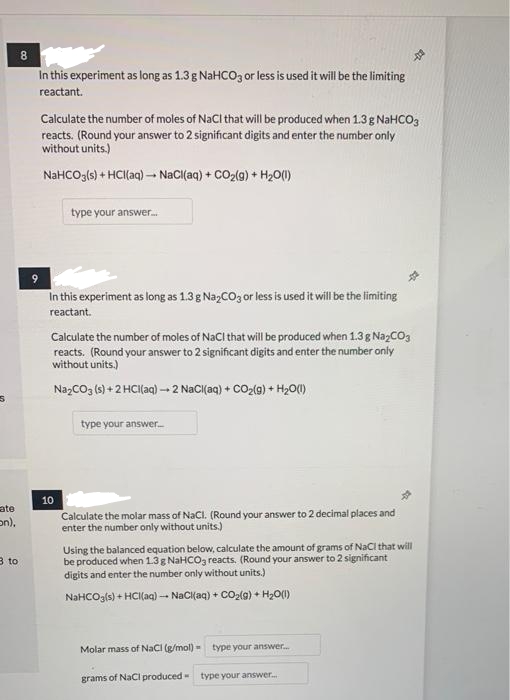8 In this experiment as long as 1.3g NaHCO3 or less is used it will be the limiting reactant. Calculate the number of moles of NaCl that will be produced when 1.3g NaHCO3 reacts. (Round your answer to 2 significant digits and enter the number only without units.) NaHCO3ls) + HCI(aq) - NaCl(aq) + COz(g) + H2O() type your answer. In this experiment as long as 1.3g NayCO3 or less is used it will be the limiting reactant. Calculate the number of moles of NaCl that will be produced when 1.3g NazCO3 reacts. (Round your answer to 2 significant digits and enter the number only without units) NazCO, (s) + 2 HCIlag) -2 NaCi(aq) + CO;(0) + H200) type your answer 10 te m). Calculate the molar mass of NaCl. (Round your answer to 2 decimal places and enter the number only without units.) Using the balanced equation below, calculate the amount of grams of NaCi that will be produced when 13g NAHCO, reacts. (Round your answer to 2 significant digits and enter the number only without units) to NaHCOgls) + HCI(ag) - NaCi{aq) + CO(@) + H,O) Molar mass of NaCI (g/mol) - type your answer. grams of NaCl produced - type your answer.
8 In this experiment as long as 1.3g NaHCO3 or less is used it will be the limiting reactant. Calculate the number of moles of NaCl that will be produced when 1.3g NaHCO3 reacts. (Round your answer to 2 significant digits and enter the number only without units.) NaHCO3ls) + HCI(aq) - NaCl(aq) + COz(g) + H2O() type your answer. In this experiment as long as 1.3g NayCO3 or less is used it will be the limiting reactant. Calculate the number of moles of NaCl that will be produced when 1.3g NazCO3 reacts. (Round your answer to 2 significant digits and enter the number only without units) NazCO, (s) + 2 HCIlag) -2 NaCi(aq) + CO;(0) + H200) type your answer 10 te m). Calculate the molar mass of NaCl. (Round your answer to 2 decimal places and enter the number only without units.) Using the balanced equation below, calculate the amount of grams of NaCi that will be produced when 13g NAHCO, reacts. (Round your answer to 2 significant digits and enter the number only without units) to NaHCOgls) + HCI(ag) - NaCi{aq) + CO(@) + H,O) Molar mass of NaCI (g/mol) - type your answer. grams of NaCl produced - type your answer.
Introductory Chemistry: A Foundation
9th Edition
ISBN:9781337399425
Author:Steven S. Zumdahl, Donald J. DeCoste
Publisher:Steven S. Zumdahl, Donald J. DeCoste
Chapter9: Chemical Quantities
Section: Chapter Questions
Problem 36QAP
Related questions
Question
Solve it all otherwise don't touch it

Transcribed Image Text:8
In this experiment as long as 1.3 g NaHCO3 or lessis used it will be the limiting
reactant.
Calculate the number of moles of NaCl that will be produced when 1.3g NaHCO3
reacts. (Round your answer to 2 significant digits and enter the number only
without units.)
NaHCOg(s) + HCllaq) – NaCl(aq) + CO2(g) + H20()
type your answer.
In this experiment as long as 1.3 g Na,CO3 or less is used it will be the limiting
reactant.
Calculate the number of moles of NaCl that will be produced when 1.3g NazCO3
reacts. (Round your answer to 2 significant digits and enter the number only
without units.)
NazCO3 () + 2 HCI(aq) - 2 NaCI(aq) + CO2(g) + H20)
type your answer-
10
ate
on),
Calculate the molar mass of NaCl. (Round your answer to 2 decimal places and
enter the number only without units.)
Using the balanced equation below, calculate the amount of grams of NaCl that will
be produced when 1.3g NAHCO3 reacts. (Round your answer to 2 significant
digits and enter the number only without units.)
3 to
NaHCOgls) + HCI(aq) -- NaCi{aq) + CO2(9) + H,O)
Molar mass of NaCi (g/mol) -
type your answer.
grams of NaCl produced-
type your answer.
Expert Solution
This question has been solved!
Explore an expertly crafted, step-by-step solution for a thorough understanding of key concepts.
This is a popular solution!
Trending now
This is a popular solution!
Step by step
Solved in 2 steps with 1 images

Knowledge Booster
Learn more about
Need a deep-dive on the concept behind this application? Look no further. Learn more about this topic, chemistry and related others by exploring similar questions and additional content below.Recommended textbooks for you

Introductory Chemistry: A Foundation
Chemistry
ISBN:
9781337399425
Author:
Steven S. Zumdahl, Donald J. DeCoste
Publisher:
Cengage Learning

Chemistry & Chemical Reactivity
Chemistry
ISBN:
9781337399074
Author:
John C. Kotz, Paul M. Treichel, John Townsend, David Treichel
Publisher:
Cengage Learning

Chemistry & Chemical Reactivity
Chemistry
ISBN:
9781133949640
Author:
John C. Kotz, Paul M. Treichel, John Townsend, David Treichel
Publisher:
Cengage Learning

Introductory Chemistry: A Foundation
Chemistry
ISBN:
9781337399425
Author:
Steven S. Zumdahl, Donald J. DeCoste
Publisher:
Cengage Learning

Chemistry & Chemical Reactivity
Chemistry
ISBN:
9781337399074
Author:
John C. Kotz, Paul M. Treichel, John Townsend, David Treichel
Publisher:
Cengage Learning

Chemistry & Chemical Reactivity
Chemistry
ISBN:
9781133949640
Author:
John C. Kotz, Paul M. Treichel, John Townsend, David Treichel
Publisher:
Cengage Learning

Chemistry: Principles and Reactions
Chemistry
ISBN:
9781305079373
Author:
William L. Masterton, Cecile N. Hurley
Publisher:
Cengage Learning

Chemistry by OpenStax (2015-05-04)
Chemistry
ISBN:
9781938168390
Author:
Klaus Theopold, Richard H Langley, Paul Flowers, William R. Robinson, Mark Blaser
Publisher:
OpenStax

Chemistry
Chemistry
ISBN:
9781305957404
Author:
Steven S. Zumdahl, Susan A. Zumdahl, Donald J. DeCoste
Publisher:
Cengage Learning